Wind screen wiper FIAT PALIO 2003 178 / 1.G India Version Owners Manual
[x] Cancel search | Manufacturer: FIAT, Model Year: 2003, Model line: PALIO, Model: FIAT PALIO 2003 178 / 1.GPages: 156, PDF Size: 6.27 MB
Page 7 of 156
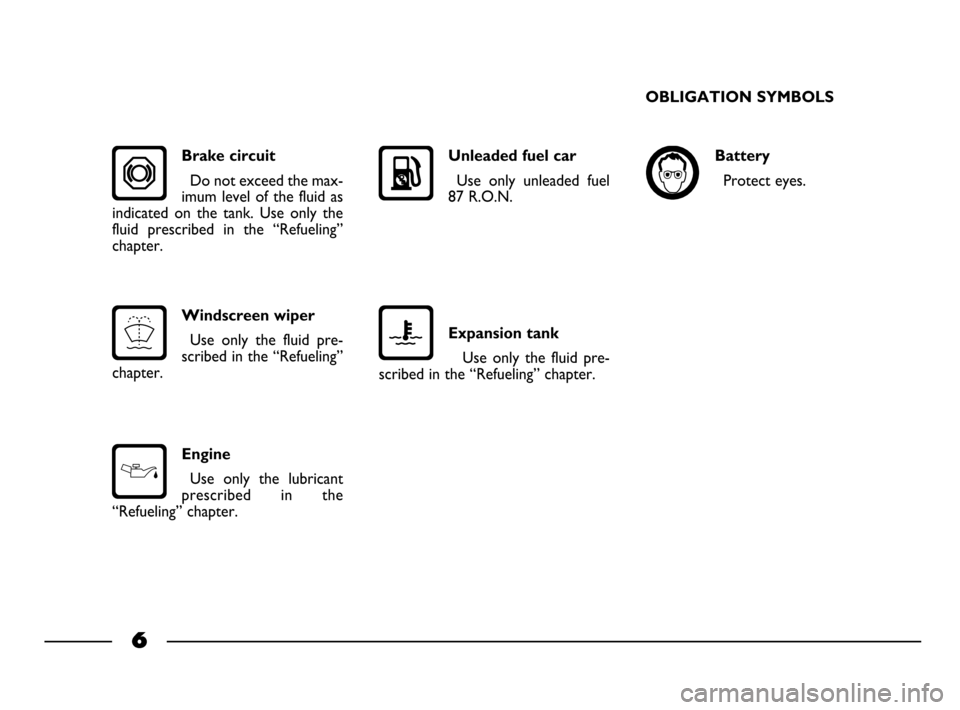
6
OBLIGATION SYMBOLS
Battery
Protect eyes.
Battery
Jack
Refer the owner
handbook.
Expansion tank
Use only the fluid pre-
scribed in the “Refueling” chapter.
Engine
Use only the lubricant
prescribed in the
“Refueling” chapter.
Unleaded fuel car
Use only unleaded fuel
87 R.O.N.
Windscreen wiper
Use only the fluid pre-
scribed in the “Refueling”
chapter.
Brake circuit
Do not exceed the max-
imum level of the fluid as
indicated on the tank. Use only the
fluid prescribed in the “Refueling”
chapter.
1-19 03/03/2003 05:44 PM Page 6
Page 10 of 156
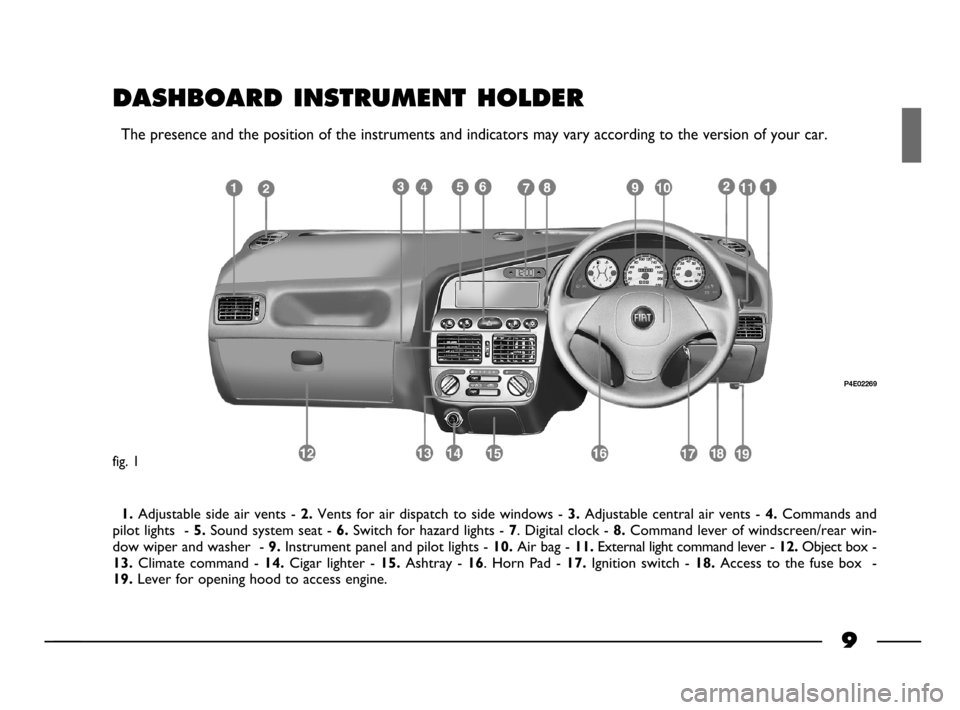
9
1.Adjustable side air vents - 2.Vents for air dispatch to side windows - 3.Adjustable central air vents - 4.Commands and
pilot lights -
5.Sound system seat - 6.Switch for hazard lights - 7. Digital clock - 8.Command lever of windscreen/rear win-
dow wiper and washer -
9.Instrument panel and pilot lights - 10.Air bag - 11.External light command lever - 12.Object box -
13.Climate command - 14.Cigar lighter - 15.Ashtray - 16. Horn Pad - 17.Ignition switch - 18.Access to the fuse box -
19.Lever for opening hood to access engine.
P4E02269
DASHBOARD INSTRUMENT HOLDER
The presence and the position of the instruments and indicators may vary according to the version of your car.
fig. 1
1-19 03/03/2003 05:44 PM Page 9
Page 14 of 156

13
STEERING COL-
UMN STALKS
RIGHT-HAND STALK fig. 12
In position A= left turn indicator
lights on.
In position
B= right turn indicator
lights on.
Pulled towards the steering wheel
= flicks.
Ring turned on
O= lights switched
off.
Ring turned on 3
= parking
lights on.
Ring turned on
2= Low beams.
With ring turned on
2& stalk
towards the dashboard = high beams.
Fig. 11
To fasten:
insert tongue A in B
on the buckle.
To loosen: press button C.
fig. 11
P4E01355
fig. 12
P4E02023
LEFT-HAND STALK fig. 13
Position A = Windscreen wipers
OFF.
Position
B= Intermittent wipe.
Position
C = Slow continuous
wipe.
Position
D = Quick continuous
wipe.
Position
E(not fixed) = Quick con-
tinuous wipe. This is a unique anti-
panic feature.
Stalk pulled towards the steering
wheel = windscreen washer activated.
Thrust towards the dashboard =
rear window washer/wiper.
Ring on
Oposition = Rearwind
screen wiper OFF.
Ring at
' '
position = Rear wind-
screen wiper ON.
fig. 13
P4E01682
1-19 03/03/2003 05:44 PM Page 13
Page 43 of 156
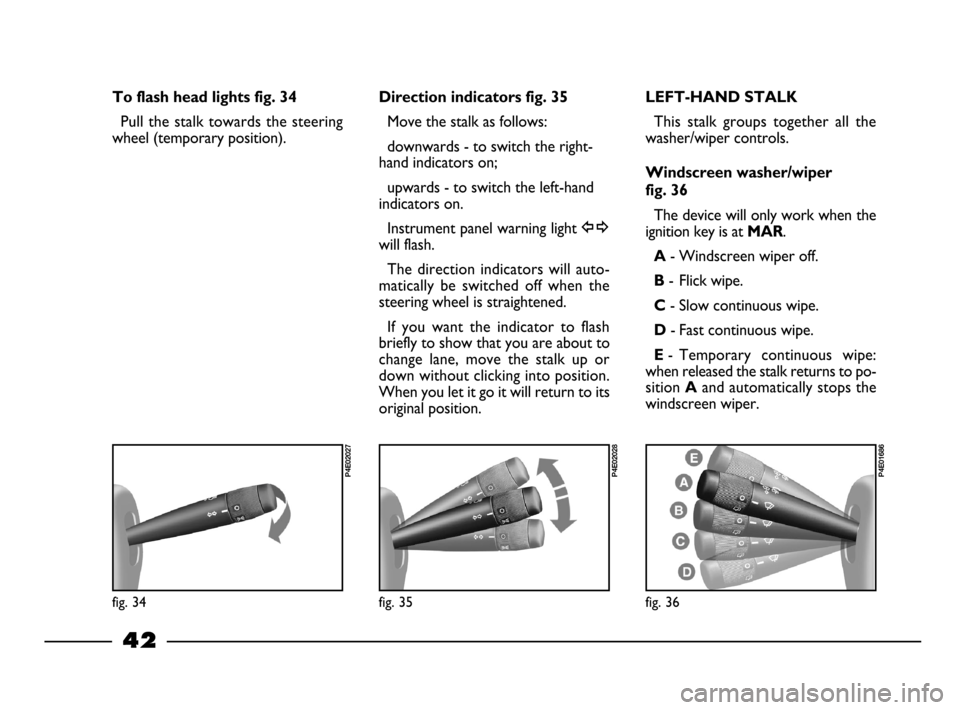
42
fig. 36
P4E01686
To flash head lights fig. 34
Pull the stalk towards the steering
wheel (temporary position).
Direction indicators fig. 35
Move the stalk as follows:
downwards - to switch the right-
hand indicators on;
upwards - to switch the left-hand
indicators on.
Instrument panel warning light
y
will flash.
The direction indicators will auto-
matically be switched off when the
steering wheel is straightened.
If you want the indicator to flash
briefly to show that you are about to
change lane, move the stalk up or
down without clicking into position.
When you let it go it will return to its
original position.
LEFT-HAND STALK
This stalk groups together all the
washer/wiper controls.
Windscreen washer/wiper
fig. 36
The device will only work when the
ignition key is at
MAR.
A- Windscreen wiper off.
B- Flick wipe.
C- Slow continuous wipe.
D- Fast continuous wipe.
E- Temporary continuous wipe:
when released the stalk returns to po-
sition
Aand automatically stops the
windscreen wiper.
fig. 35
P4E02028
fig. 34
P4E02027
20-63 03/03/2003 06:02 PM Page 42
Page 44 of 156
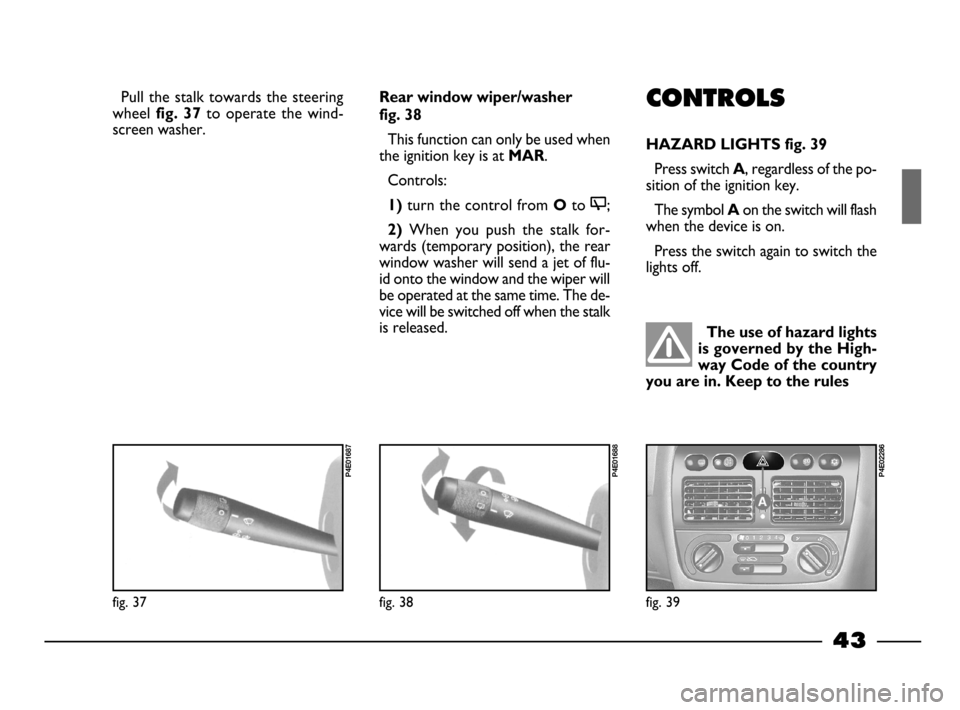
43
Pull the stalk towards the steering
wheel
fig. 37 to operate the wind-
screen washer.
The use of hazard lights
is governed by the High-
way Code of the country
you are in. Keep to the rules
CONTROLS
HAZARD LIGHTS fig. 39
Press switchA, regardless of the po-
sition of the ignition key.
The symbol
Aon the switch will flash
when the device is on.
Press the switch again to switch the
lights off.
fig. 37
P4E01687
fig. 38
P4E01688
fig. 39
P4E02286
Rear window wiper/washer
fig. 38
This function can only be used when
the ignition key is at
MAR.
Controls:
1)turn the control from Oto ' ';
2)When you push the stalk for-
wards (temporary position), the rear
window washer will send a jet of flu-
id onto the window and the wiper will
be operated at the same time. The de-
vice will be switched off when the stalk
is released.
20-63 03/03/2003 06:02 PM Page 43
Page 55 of 156
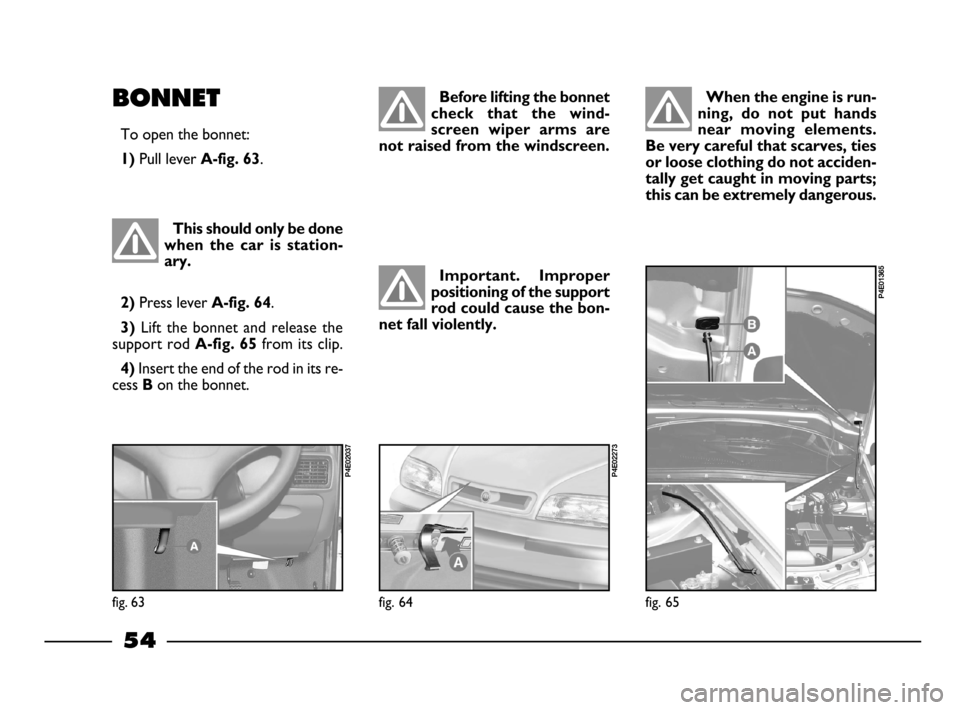
54
When the engine is run-
ning, do not put hands
near moving elements.
Be very careful that scarves, ties
or loose clothing do not acciden-
tally get caught in moving parts;
this can be extremely dangerous.BONNET
To open the bonnet:
1) Pull lever A-fig. 63.
fig. 64
P4E02273
fig. 65
P4E01365
Before lifting the bonnet
check that the wind-
screen wiper arms are
not raised from the windscreen.
Important. Improper
positioning of the support
rod could cause the bon-
net fall violently.
This should only be done
when the car is station-
ary.
2)Press lever A-fig. 64.
3)Lift the bonnet and release the
support rod
A-fig. 65from its clip.
4)Insert the end of the rod in its re-
cess
Bon the bonnet.
fig. 63
P4E02037
20-63 03/03/2003 06:03 PM Page 54
Page 72 of 156
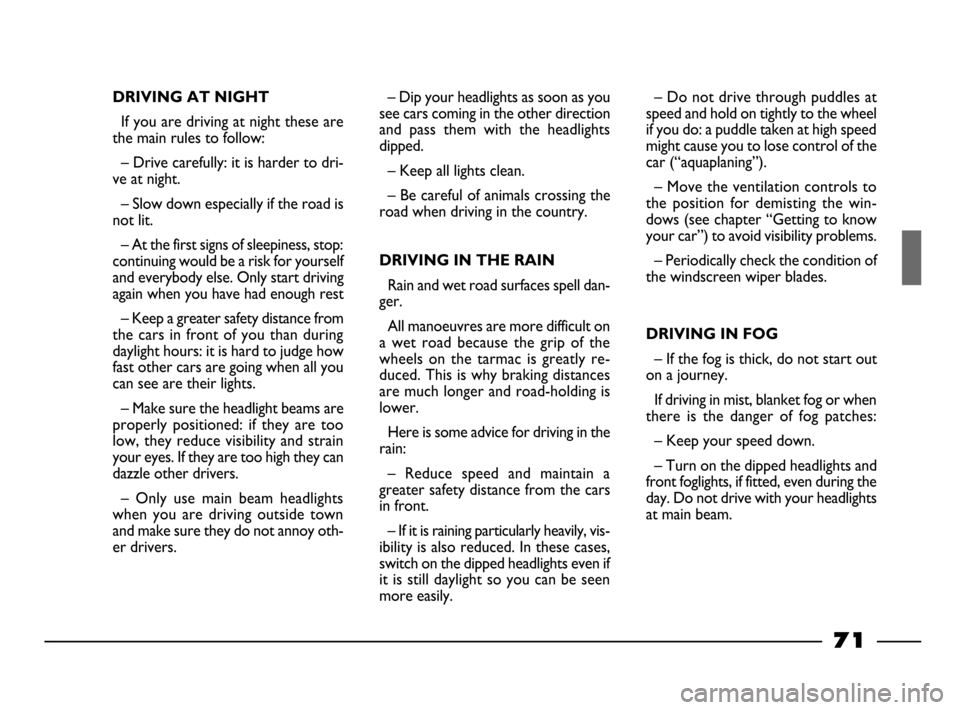
71
DRIVING AT NIGHT
If you are driving at night these are
the main rules to follow:
– Drive carefully: it is harder to dri-
ve at night.
– Slow down especially if the road is
not lit.
– At the first signs of sleepiness, stop:
continuing would be a risk for yourself
and everybody else. Only start driving
again when you have had enough rest
– Keep a greater safety distance from
the cars in front of you than during
daylight hours: it is hard to judge how
fast other cars are going when all you
can see are their lights.
– Make sure the headlight beams are
properly positioned: if they are too
low, they reduce visibility and strain
your eyes. If they are too high they can
dazzle other drivers.
– Only use main beam headlights
when you are driving outside town
and make sure they do not annoy oth-
er drivers.– Dip your headlights as soon as you
see cars coming in the other direction
and pass them with the headlights
dipped.
– Keep all lights clean.
– Be careful of animals crossing the
road when driving in the country.
DRIVING IN THE RAIN
Rain and wet road surfaces spell dan-
ger.
All manoeuvres are more difficult on
a wet road because the grip of the
wheels on the tarmac is greatly re-
duced. This is why braking distances
are much longer and road-holding is
lower.
Here is some advice for driving in the
rain:
– Reduce speed and maintain a
greater safety distance from the cars
in front.
– If it is raining particularly heavily, vis-
ibility is also reduced. In these cases,
switch on the dipped headlights even if
it is still daylight so you can be seen
more easily. – Do not drive through puddles at
speed and hold on tightly to the wheel
if you do: a puddle taken at high speed
might cause you to lose control of the
car (“aquaplaning”).
– Move the ventilation controls to
the position for demisting the win-
dows (see chapter “Getting to know
your car”) to avoid visibility problems.
– Periodically check the condition of
the windscreen wiper blades.
DRIVING IN FOG
– If the fog is thick, do not start out
on a journey.
If driving in mist, blanket fog or when
there is the danger of fog patches:
– Keep your speed down.
– Turn on the dipped headlights and
front foglights, if fitted, even during the
day. Do not drive with your headlights
at main beam.
64-79 03/03/2003 06:45 PM Page 71
Page 73 of 156
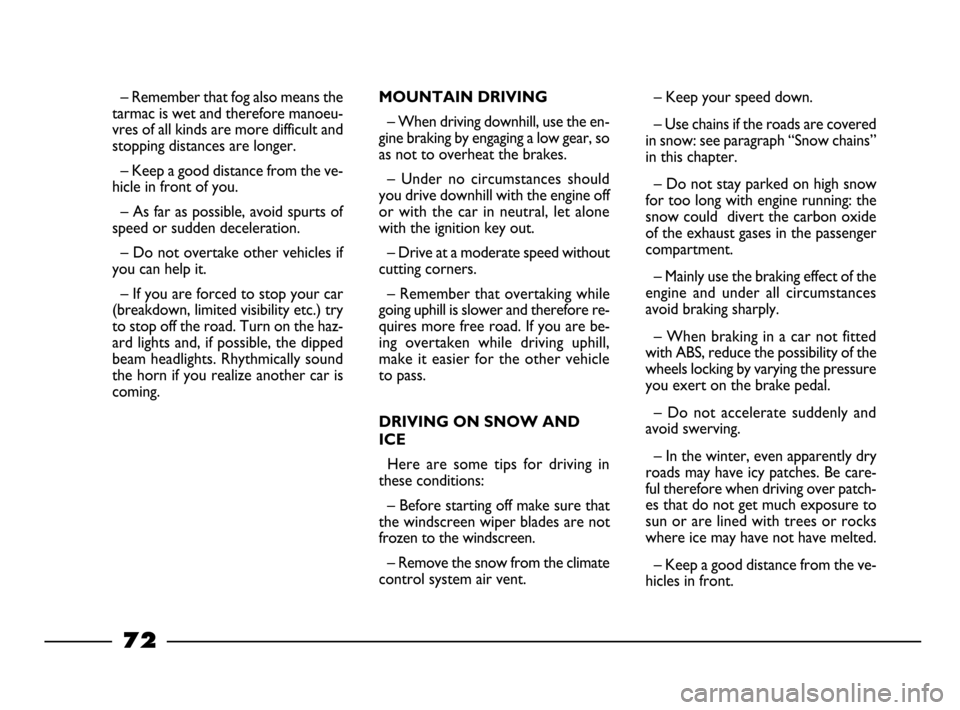
72
– Remember that fog also means the
tarmac is wet and therefore manoeu-
vres of all kinds are more difficult and
stopping distances are longer.
– Keep a good distance from the ve-
hicle in front of you.
– As far as possible, avoid spurts of
speed or sudden deceleration.
– Do not overtake other vehicles if
you can help it.
– If you are forced to stop your car
(breakdown, limited visibility etc.) try
to stop off the road. Turn on the haz-
ard lights and, if possible, the dipped
beam headlights. Rhythmically sound
the horn if you realize another car is
coming.MOUNTAIN DRIVING
– When driving downhill, use the en-
gine braking by engaging a low gear, so
as not to overheat the brakes.
– Under no circumstances should
you drive downhill with the engine off
or with the car in neutral, let alone
with the ignition key out.
– Drive at a moderate speed without
cutting corners.
– Remember that overtaking while
going uphill is slower and therefore re-
quires more free road. If you are be-
ing overtaken while driving uphill,
make it easier for the other vehicle
to pass.
DRIVING ON SNOW AND
ICE
Here are some tips for driving in
these conditions:
– Before starting off make sure that
the windscreen wiper blades are not
frozen to the windscreen.
– Remove the snow from the climate
control system air vent. – Keep your speed down.
– Use chains if the roads are covered
in snow: see paragraph “Snow chains”
in this chapter.
– Do not stay parked on high snow
for too long with engine running: the
snow could divert the carbon oxide
of the exhaust gases in the passenger
compartment.
– Mainly use the braking effect of the
engine and under all circumstances
avoid braking sharply.
– When braking in a car not fitted
with ABS, reduce the possibility of the
wheels locking by varying the pressure
you exert on the brake pedal.
– Do not accelerate suddenly and
avoid swerving.
– In the winter, even apparently dry
roads may have icy patches. Be care-
ful therefore when driving over patch-
es that do not get much exposure to
sun or are lined with trees or rocks
where ice may have not have melted.
– Keep a good distance from the ve-
hicles in front.
64-79 03/03/2003 06:45 PM Page 72
Page 76 of 156

75
CONTAINING RUNNING COSTS
AND POLLUTION
Tyres
Tyre pressure should be checked at
least once every four weeks: if the
pressure is too low fuel consumption
increases as the resistance to the
rolling movement of the tyre is
greater. In this state, tyre wear is in-
creased and handling suffers which will
effect safety.
Unnecessary loads
Do not travel with too much load in
the boot. The weight of the car (above
all in the urban traffic)and its trim
greatly effects consumption and sta-
bility.
Roof rack/ski rack
Remove roof racks and ski racks
from the roof of the car as soon as
they are no longer needed. These ac-
cessories reduce the aerodynamic
penetration of the car and will increase
consumption.
Electrical devices
Use electric devices for the neces-
sary time only. The heated rear win-
dow, additional lights, windscreen
wipers, heater, fan of the heating sys-
tem require large amounts of elec-
tricity and increasing the request for
power will also increase fuel con-
sumption (up to +25% when driving in
towns). Some suggestions which may help
you to keep the running costs of the
car down and lower the amount of
toxic emissions released into the at-
mosphere are given below.
GENERAL
CONSIDERATIONS
Car maintenance
The overall state of the car is an im-
portant factor which has a marked in-
fluence over fuel consumption and dri-
ving comfort and on the life span of
your car. For this reason care should
be taken to maintain your car by car-
rying out the necessary checks and
regulations in accordance with the
specifications given in the service
schedule (see sections: spark plugs,
idling, air cleaners, timing).
64-79 03/03/2003 06:45 PM Page 75
Page 79 of 156
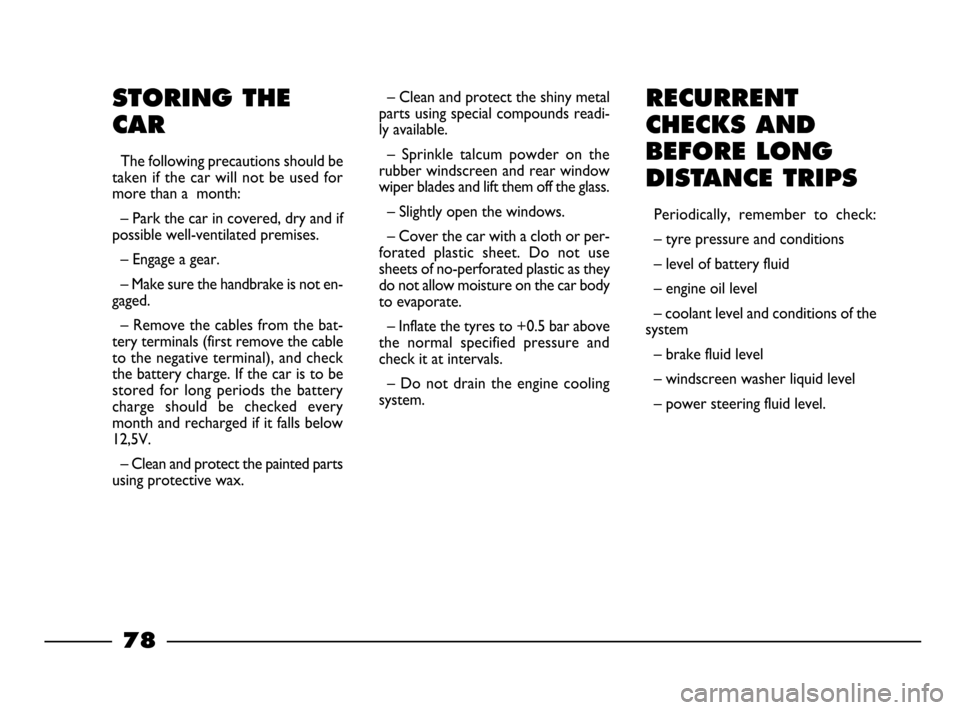
78
RECURRENT
CHECKS AND
BEFORE LONG
DISTANCE TRIPS
Periodically, remember to check:
– tyre pressure and conditions
– level of battery fluid
– engine oil level
– coolant level and conditions of the
system
– brake fluid level
– windscreen washer liquid level
– power steering fluid level.
STORING THE
CAR
The following precautions should be
taken if the car will not be used for
more than a month:
– Park the car in covered, dry and if
possible well-ventilated premises.
– Engage a gear.
– Make sure the handbrake is not en-
gaged.
– Remove the cables from the bat-
tery terminals (first remove the cable
to the negative terminal), and check
the battery charge. If the car is to be
stored for long periods the battery
charge should be checked every
month and recharged if it falls below
12,5V.
– Clean and protect the painted parts
using protective wax.– Clean and protect the shiny metal
parts using special compounds readi-
ly available.
– Sprinkle talcum powder on the
rubber windscreen and rear window
wiper blades and lift them off the glass.
– Slightly open the windows.
– Cover the car with a cloth or per-
forated plastic sheet. Do not use
sheets of no-perforated plastic as they
do not allow moisture on the car body
to evaporate.
– Inflate the tyres to +0.5 bar above
the normal specified pressure and
check it at intervals.
– Do not drain the engine cooling
system.
64-79 03/03/2003 06:45 PM Page 78